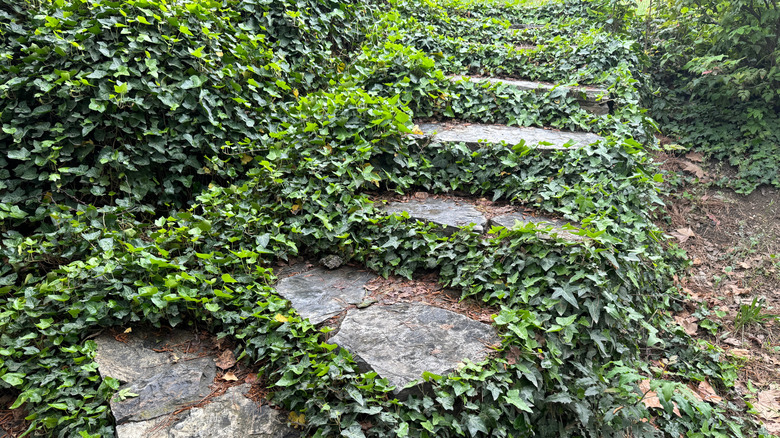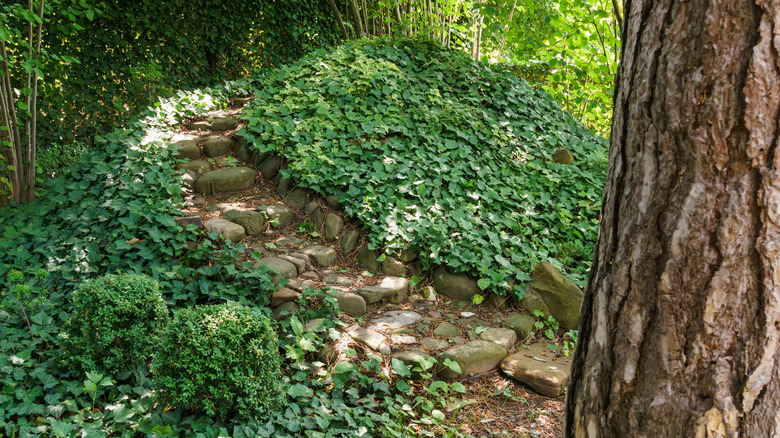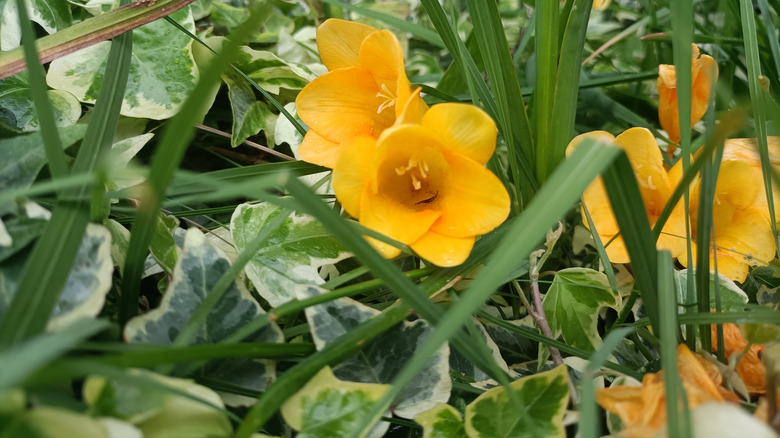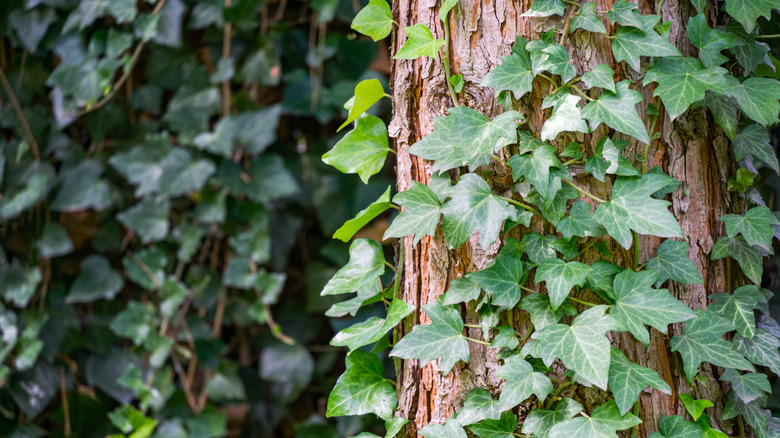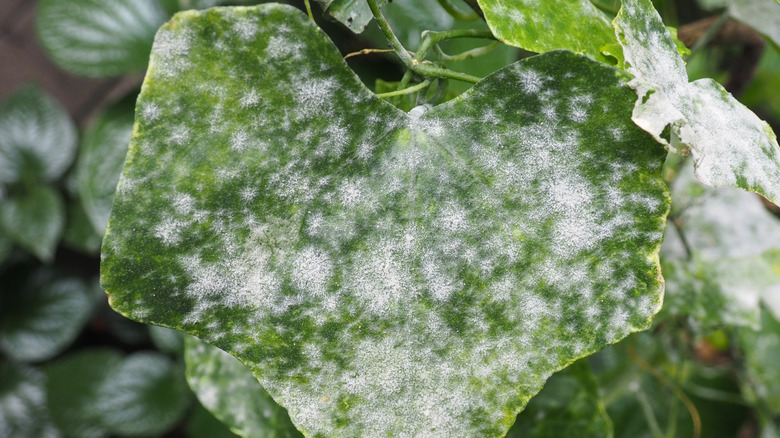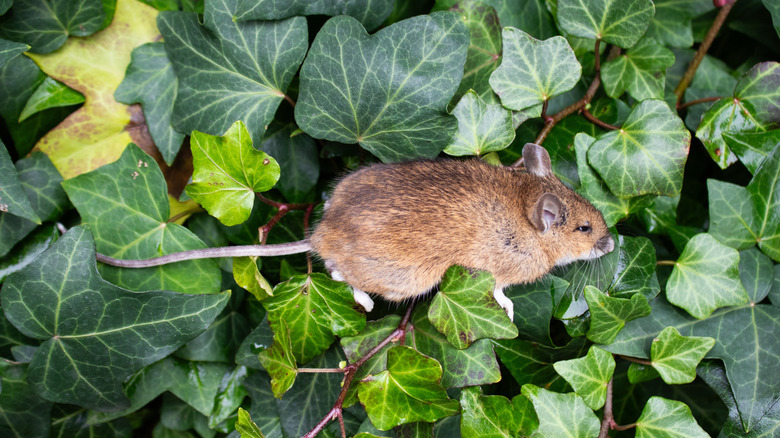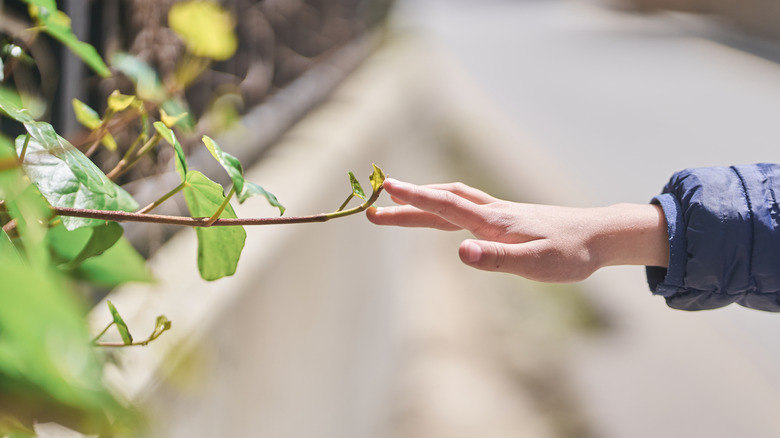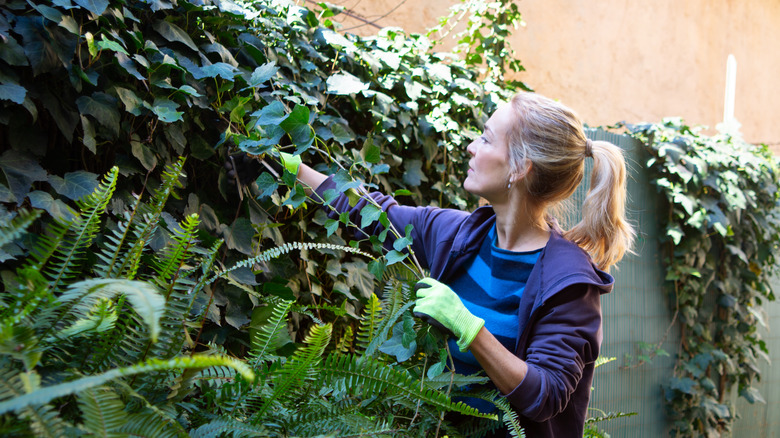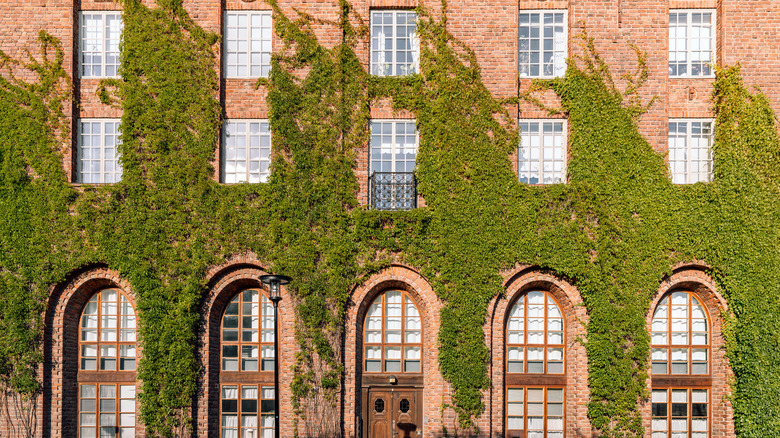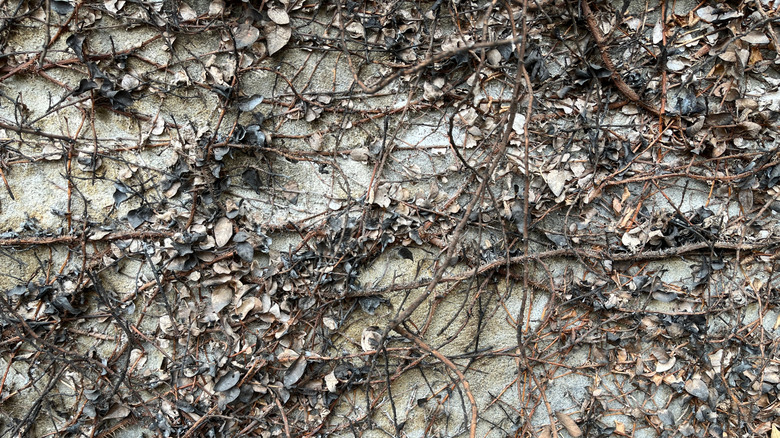10 Reasons To Reconsider Growing The Popular Ground Cover English Ivy
English ivy (Hedera helix) just has a timeless look to it, don't you think? Whether it's filling bare patches of garden or climbing up an ancient home's wall, that lush green vine is a sight to behold. Yet, there's more than meets the eye with this ground cover — a lot more, in fact — and much of it can be detrimental to you, your family, your garden, and even your home.
That's why we're breaking down 10 reasons you should seriously consider opting for a different ground cover for your landscape. Even though we love the look of English ivy, in the end, there are just too many risks you'll need to take into account, and the damage to your garden's aesthetic, wallet, and sanity can be irreparable. So, let's talk about why we think English ivy is a ground cover with more downsides than benefits, as well as the damage that can happen if you decide to go for it anyhow. Just don't say we didn't warn you.
It's aggressively invasive and you'll probably never get rid of it
English ivy is good at one thing: spreading. Birds disperse its seeds when they eat it and it can crawl itself along almost any texture or terrain by putting down roots — literally. So, even if you plant it and decide you've made a mistake, you'll probably never be able to fully get rid of it; it's just way too sneaky and is incredibly adept at regenerating. Though, look, we get why some people would ignore this and plant it anyhow. H. helix grows in spots that are typically too shady for more full sun-loving ground covers and nothing says "English garden" more than, well, English ivy. But if you ignore our warning and decide to go for it, here's what you're in for.
Successfully removing it from the ground requires at least two people: one to pull the vines taut and the other to cut the stems as close to the ground as possible. But even then, you're not guaranteed to get all of it, because it can regenerate from a single cut stem or vine accidentally left behind. It's also drought-tolerant to the point that it can come back even after being set on fire. Not because it's a zombie — although it kinda feels that way — but because even one seed or viable stem left is all it needs to get growing again.
It kills other plants and will mess up your local environment
English ivy's mission, it seems, is to survive at all costs. So, when you're not paying attention, it'll crawl over anything in its way, including other plants. You see, English ivy is a very grumpy and vindictive neighbor that doesn't play nicely with others. Instead, it smothers anything remotely resembling competition, which is a problem in itself, but has grave consequences for your environment, too.
The way ivy ensures its dominance is by wrapping its vines around foliage, preventing it from photosynthesizing, while also outcompeting it for soil, nutrients, water, and light. Ivy's roots are also shallow, so they can smother other plant's roots similarly to how compacted soil does. If those plants happen to be native to your area, the damage gets even worse. Consequently, your local pollinators and wildlife that depends on the nutrition they get from native plants' nectar, pollen, and seeds lose their food sources. So, save the bees and opt for English ivy alternatives for your garden that are native plants instead, like alumroot (Heuchera micrantha/maxima), foamflower (Tiarella cordifolia) or climbing hydrangea (Hydrangea barbara).
It can kill or harm trees, too
You'd think trees could withstand a little climbing vine, right? Unfortunately for trees, a "little climbing vine" can turn into a big problem faster than you think, especially when the vine in question is English ivy. H. helix doesn't realize it's supposed to stay put as a ground cover and will begin winding its way up tree trunks, looking for the optimal space to access light, water, and nutrients — all to the detriment of the tree.
As it gets established on the trunk, the ivy's vines get bulkier and heavier, which ends up weighing more than you'd think. The tree's trunk is built to support itself; no stowaways were added into that calculation, so it can begin to wither and decline. Things might look okay at first, but before you realize it, the ivy has wound its way around the branches, suffocating the foliage and making it harder for the tree to photosynthesize. Eventually, the tree can't manage anymore and may become so weak that it can't withstand the onslaught that comes with a good thunderstorm and may blow over. Not only will that mean you've got a dead tree to clear, but now your insurance company is taking notice of the landscape. Repeat problems or a lack of preventative tree maintenance could cause your homeowner's premiums to rise, especially if it damages you or your neighbors' property, and you may need to remove trees from your yard to maintain coverage.
It's a breeding ground for dangerous plant pathogens
English ivy isn't just a nuisance because of its invasive behaviors — it's also a breeding ground for dangerous plant pathogens. Bacterial leaf scorch (Xylella fastidiosa), leaf spots, cankers, stem rot, and powdery mildew all have a history of thriving quite nicely when H. helix is around. Just imagine trying to stop an outbreak of powdery mildew from affecting your garden or trees when its delivery system is an insatiable vine that is nearly impossible to eradicate? Yeah, it's a straight up nightmare.
So, let's talk about what this would really look like should your ivy cause an outbreak of any of these pathogens on the rest of your plants. Xylella fastidiosa, also known as "golden death," primarily affects grapevines, almond trees, oleander trees, and olive trees. It moves through a plant's xylem, the tissue that moves water and nutrients to the stems and leaves, eventually killing it, as there is currently no known cure. Leaf spots affect multiple plants and are caused by several types of bacteria and fungi, which cause your plant's leaves to drop prematurely, stressing the plant out. Pseudomonas syringae, the bacteria behind cankers, affects leaves, flowers, and fruits of multiple plants, causing lesions or killing them off totally. Phoma and Mycosphaerella spp. are the fungi behind stem rot and create black lesions on stems, eventually killing off the root systems. Phoma spp. primarily affects food crops, while Mycosphaerella thrives on eucalyptus, fruits, peas, and grains.
It can also be a home for rodents and insects
If killer plant pathogens weren't enough, pests and rodents absolutely love to nest under the dense foliage of English ivy. Mice, voles, aphids, mealybugs, caterpillars, mites, scale, loopers — you name it — and it's likely to have made English ivy its home. All of that dense canopy not only provides pests of all sizes a safe space to sleep or hide their young, but it's also like giving them a free system of secret tunnels right to your trees, shrubs, and garden.
Letting this utopian pest paradise grow unchecked is nothing but an invitation for critters to make a bad problem worse. As the ivy comes in contact with another plant, insects will migrate from the ivy to begin feeding on the sap of your healthy garden plants and trees, weakening them so they become a target for pathogens. But, that's only the start of the problem, because the growing rodent population hidden under the vines can go from annoying to dangerous in no time. Voles will create an underground network of tunnels to feast on roots and bulbs. Then, their little mice friends move into the tunnels and eventually find a way from them to your home's foundation, and then into your home. After that, you can expect chewed electrical wires, shredded insulation, smelly and impossible-to-find poop or corpses, and an increasingly higher rodent control bill being delivered to your mailbox. By the way, if you already have a pest control problem, you're in luck because you can swap English ivy and its open rodent invitation for a fragrant ground cover that deters pests instead.
It's incredibly toxic
As if it wasn't enough of a nuisance, English ivy has a chemical makeup that can seriously harm humans and animals. All parts of the plant contain triterpenoid saponins and polyacetylene compounds, which can cause anything from a mild skin irritation to hallucinations, fever, rashes, diarrhea — you name it. And while you may teach your children to avoid eating mysterious berries, it's actually H. helix's foliage that's more that most toxic part.
Letting a toxic plant like English ivy dominate your landscape when there are small kids or pets around is only asking for trouble, because it significantly increases the chance of accidental poisoning. A curious toddler with a history of putting things in their mouths, a bored dog looking to pass the time with a little snack, or even the livestock on your farm rubbing their faces on the vines can result in an emergency visit to the vet or doctor. So, do right by protecting your most vulnerable family members and opt for a non-toxic ground cover, instead, like southern maidenhair fern (Adiantum capillus-veneris) or woolly yarrow (Achillea tomentosa).
It's not as low maintenance as you've heard
Somehow, the idea got around that English ivy is a "plant-it-and-forget-it" ground cover, but that's a myth. The truth is that H. helix is incredibly high maintenance and requires aggressive, consistent pruning to keep it from getting out of control. You'll be spending most of your gardening time in a relentless chopping battle to ensure its dense foliage is too thin to hide the aforementioned critters or pathogens, or keeping a close eye on its growth to prevent it from smothering its neighboring plants.
Neglecting your pruning chores for only a month can be all it needs to dominate your yard and garden. It will creep along until it finds a structure to climb, like a prized tree or wall, and then you're really in trouble. The aerial rootlets will work their ways into the tiniest opening possible where they can thrive and you can't get to, becoming a never ending saga where it's likely the ivy will triumph over your will. So, save yourself the Sisyphean struggle and either commit to a regular aggressive assault or give yourself a little self-care by picking something less unruly.
It will damage your home's structure if allowed to grow on its walls
The romantic image of an ancient building covered in ivy hides the stark and destructive reality a climbing ground cover like English ivy can cause. H. helix's structural damage has a three-pronged attack. First, it uses tiny rootlets to grab onto the wall, eventually making their ways into the smallest hole or cracks, anchoring the vine and widening fissures in mortar, wood, siding, or whatever you've got. Next, that dense foliage traps moisture against the walls, causing paint to peel, wood to rot, bricks to crumble, and, oh, here comes the mold it invited to its housewarming party. Finally, remember those insects we discussed above? Two we didn't mention that aren't really interested in other plants, but become pertinent when your home is involved, are carpenter ants and termites. These pests use the vines as ladders to find a way into your home's framework, damaging it from the inside.
Here's the harsh truth about that cottagecore look of ivy on your walls: allowing it to take over is like agreeing to a slow, systematic dismantling of your home. It starts off as just small cosmetic damages, like a stained piece of siding here or a little peeling paint there, but that's only the beginning. On brick homes, those rootlets and trapped moisture will begin degrading mortar until bricks begin to loosen and compromise the wall's stability. For wood siding, the consistent dampness will create soft spots in the wood that decays away, making an excellent entry point for an infestation. For homes with siding, the vines will pull panels away, exposing internal sheathing and structural studs to the elements. Opting to go for the English ivy aesthetic over safety won't just lead to an expensive repair job, it can lead to catastrophic failure of one of the biggest purchases you'll make in your life.
It's potentially a fire risk for homes and trees
Let us introduce you to a new term: fire ladder. A fire ladder is vegetation that creates a continuous fuel source for flames, starting at the ground level and moving upward to higher ground, like a tree's canopy or the eaves of your home. English ivy's leaves have a waxy coating that may make them feel fireproof, but the dense, matted growth underneath hides a smorgasboard of dead leaves, twigs, and woody stems. If a spark hits that undergrowth, there's no stopping it until the fuel source is used up.
However, not all experts agree on the flammability level of H. helix, because of its high moisture content. But we think it's better to be safe than sorry, particularly if it grows over things that are more vulnerable to igniting, like dry plants or wooden structures. In the worst case scenario, a small, manageable ground fire that might've extinguished itself can ignite the base of ivy and move quickly up a tree, creating a devastating crown fire that almost certainly kills it. If the flame reaches ivy touching your home, it can move up any dry stems or leaves and reach wooden slats, window frames, roof eaves, and other flammable surfaces. What may have started as a minor event can become a full-blown structural fire that may lead to a total loss, all thanks to the ivy's fire ladder.
